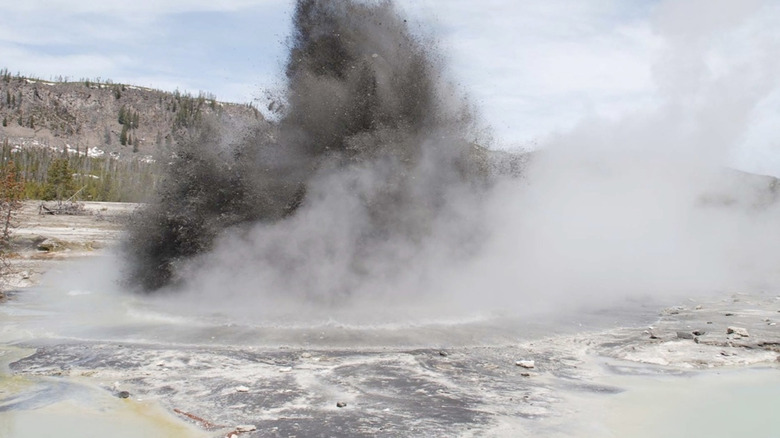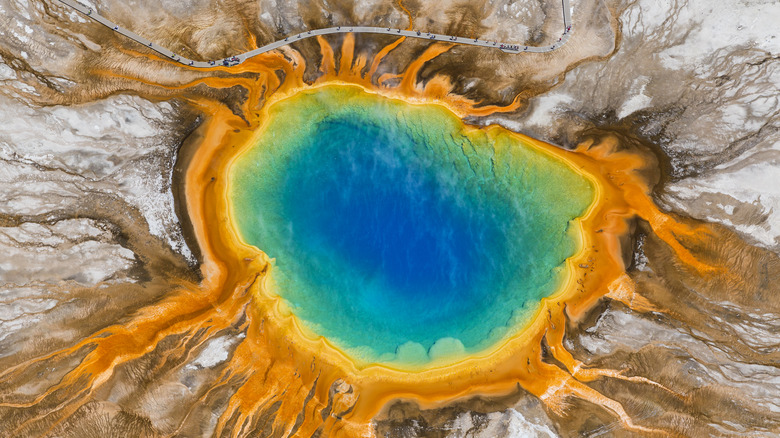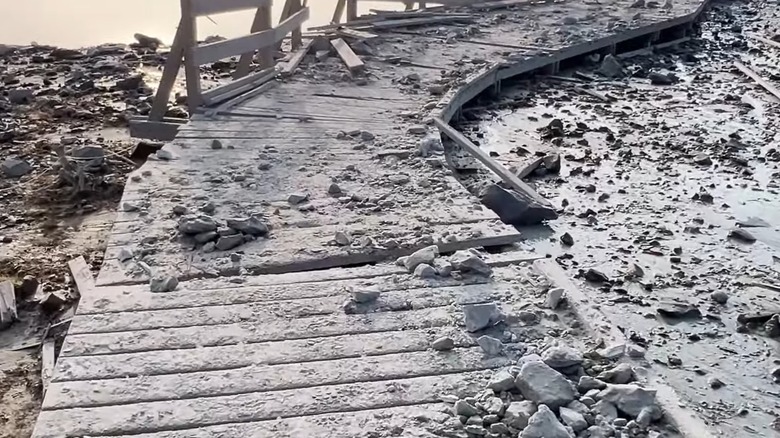What Caused The Yellowstone Biscuit Basin Explosion And Could It Happen Again?
Every year, millions travel to Yellowstone to bask in its stunning array of natural wonders and partake of the tranquility of thousands of miles of untouched land. But beneath that tranquility, the ground is restless, ready to erupt at a moment's notice. Yellowstone is peppered with over 500 geysers that can shoot superheated water hundreds of feet into the air and dotted with thousands of hot springs, boiling pits of mud, and steaming vents. Normally, these features are relatively stable and draw a steady stream of visitors, but occasionally, Yellowstone's thermal releases are large enough to put park visitors in danger.
Such an event happened on July 23, 2024, when an explosion in the Black Diamond Pool in Yellowstone's Biscuit Basin sent a plume of rock, water, and mud over 400 feet into the air as tourists watched in awe from the nearby boardwalk. Thankfully, the explosion was directed away from the visitors, but the explosion was strong enough to hurl boulders weighing hundreds of pounds out of the small pond and badly damage the nearby boardwalk. So, how did this happen, and will it happen again?
The geology of Yellowstone National Park
Yellowstone National Park's unique hydrothermal features are due to an unusually hot and active portion of the Earth's mantle called a hotspot. The precise origins of hotspots are unknown, but they manifest on the Earth's surface as volcanic activity. When there is a hotspot under the ocean, it produces an island chain like Hawaii with successively more eroded islands left in the wake of the crust's tectonic movement.
The volcanic hotspot beneath Yellowstone is a lot larger than the one beneath Hawaii. Whereas the Hawaiian hotspot produces the volcanoes you're used to, the Yellowstone hotspot has produced supervolcanoes capable of causing mass extinctions, and instead of leaving a chain of islands in its wake, it's left a trail of caldera, which are volcanic craters from past supereruptions. This volcanic hotspot beneath Yellowstone is also relatively unique in that it lies beneath an area with a large amount of groundwater. The upwelling of heat and gas from the Earth's mantle heats up the water above it, giving rise to the geysers, mudpots, hot springs, and fumaroles of the park.
What happened at Yellowstone's Biscuit Basin?
The massive eruption at Yellowstone's Biscuit Basin in July 2024 was what's known as a hydrothermal explosion. Due to the park's restless seismic activity, the ground is always expanding and contracting, and sometimes that movement opens up a space for groundwater to fill, before being covered by either sediments or seismic activity. That trapped water is then heated up by the hotspot underneath the park, but with nowhere to go it becomes superheated, unable to boil into a gas due to the immense pressure of the Earth. When that pocket of water is released, the drop in pressure allows it to rapidly turn into steam, the sudden expansion of which causes an explosion.
Hydrothermal explosions are believed to be a relatively common phenomenon at Yellowstone, happening multiple times a year, but usually they go unfilmed and unnoticed. An explosion of the size that occurred at Biscuit Basin happens once every ten years or so. As far as hydrothermal explosions go, this one was relatively small. Some craters from past explosions in the park are hundreds of feet in diameter, and the largest is over a mile wide. In other words, there'll undoubtedly be another explosion at Yellowstone, the only question is when.


